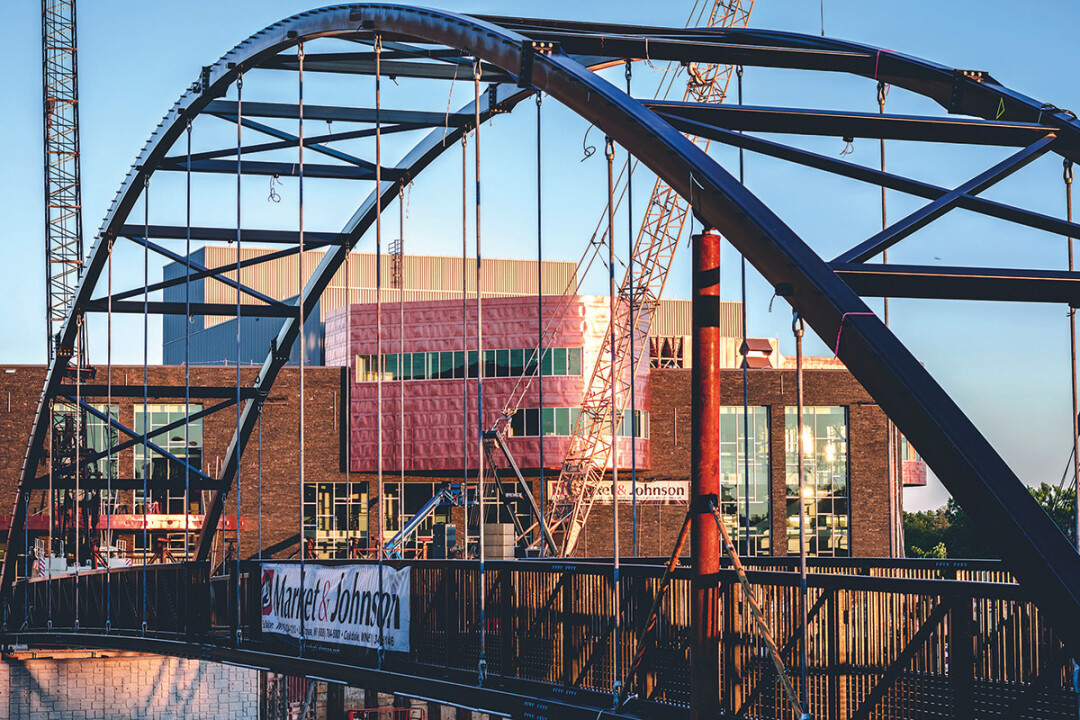Bridge to the Future: Span installed over river; Haymarket Plaza work next
Tom Giffey, photos by Taylor Smith |

The future is rapidly taking shape on the banks of the Chippewa and Eau Claire rivers – and not just in the form of the Pablo Center at the Confluence. The installation in early July of a bridge crossing the Eau Claire River between Phoenix Park and the soon-to-be-built Haymarket Plaza is just the latest visible sign of downtown Eau Claire’s transformation.
“I’m very pleased at the progress so far,” said City Engineer Dave Solberg when asked about the ongoing work, the completion of which is expected to roughly coincide with the opening of the Pablo Center this fall. Solberg said he’s gotten positive feedback about the projects from the public. “Everybody is so excited about the bridge, and the plaza, and the wall going up.”
Here’s an update on these related public projects in downtown Eau Claire, which are expected to cost a total of $5 million.
PEDESTRIAN BRIDGE
The steel pedestrian bridge over the Eau Claire River was built by Anderson Bridges in Colfax and was delivered in sections, beginning just after Independence Day. With the help of a crane atop a floating barge, the sections were quickly lifted into place. “The first day was a little bit slow, just getting started,” Solberg said. “Once they got that first day under their belt, it was just like a duck to water.” The bridge, he noted, fit to within a quarter-inch of what was expected – pretty impressive for a 210-foot span.
The structure is what is known as a tied-arch bridge (or a bowstring-arch bridge): The two ends of the arch are connected with a truss (in this case, the surface of the bridge itself), which means the outward force of the arch helps hold the bridge upright. The upshot is that there is no need to install footings in the river, which made it easier to get environmental permits for the bridge from the Department of Natural Resources, Solberg said. The lack of footings also will make is easier for Eau Clare River users, who won’t have to navigate around obstructions on their way to the Chippewa River.
The entire bridge project will cost about $1.5 million, Solberg said. The bridge, wood decking, and installation will total about $800,000, with the remainder going to walls needed on the riverbanks.
RETAINING WALL
And speaking of walls, retaining walls may be the least enthralling but most necessary part of the project. Without them, plaza, bridge, and buildings would slide into the water. The poorer-than-expected quality of soil at the Haymarket Plaza site meant the retaining wall will be more expensive than projected. In the city’s early days, everything from waterlogged chunks of wood to the debris from burned-down buildings was used as fill, leading to instability at the site, Solberg said. The problem was solved by using metal pilings driven deep into the earth, which added another $800,000 to the cost of the wall. To balance out the unexpected cost, the city won’t extend a riverwalk along the Chippewa River to Lake Street this year as originally planned. Instead, the riverwalk will stretch only to the Pablo Center this year, with the rest of the work waiting until 2019.
HAYMARKET PLAZA
Work on the Haymarket Plaza – a broad public space connecting the Pablo Center with the nearby Haymarket Landing building – has yet to begin. In June, the City Council approved a bid for the project of $1.85 million from Menomonie. Construction is scheduled to start within the next few weeks and to end by October. The plaza is expected to feature decorative stone, green space, benches, artwork, and an entranceway to the arts center as well as fire and water elements and a stairway to the water for fishing and recreation.






















